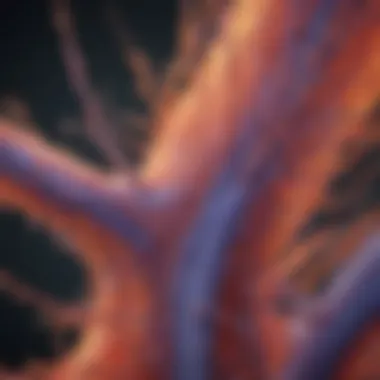Exploring Human Plasma Fibronectin: Structure and Function


Intro
Human plasma fibronectin is not just a word thrown about in scientific discussions; it serves as a linchpin in understanding a myriad of biological processes. Found in the extracellular matrix and circulating throughout blood plasma, this glycoprotein finds its place at the heart of how cells interact with their environment. Its structural integrity and functional abilities play a pivotal role in processes such as cell adhesion, differentiation, and tissue repair.
Understanding fibronectin is like peeling an onion. Each layer reveals essential insights into cellular mechanisms, offering implications that can reshape medical and biological research. This article navigates through its various dimensions—from its well-structured makeup to the latest discoveries that illuminate its function and clinical relevance. Dive in as we synthesize the remarkable facets of fibronectin, thereby broadening our comprehension of its significance in health and disease.
Foreword to Human Plasma Fibronectin
Understanding human plasma fibronectin is like peeling back the layers of a complex biological puzzle that plays a monumental role in various physiological processes. This glycoprotein is not just a mere passerby in the bloodstream; it acts as a central player in the extracellular matrix, facilitating cell adhesion, signaling, and tissue repair. In the broader context of medicine and biology, fibronectin's structural and functional characteristics have far-reaching implications, making it essential for students, researchers, and healthcare professionals alike to grasp its significance.
Definition and Overview
Fibronectin is a high-molecular-weight glycoprotein found in the extracellular matrix and plasma of humans. It is characterized by its complex structure, which includes multiple domains responsible for binding to other proteins, cells, and the extracellular matrix components. This multifunctionality enables it to play several key roles in biological processes, especially in wound healing and development.
To put it simply, think of fibronectin as a glue that holds cells together and helps them communicate. Its ability to bind to integrins — the cell surface receptors — is particularly crucial for cell adhesion and migration. When cells need to move around, whether to heal a wound or form new tissue, fibronectin is usually right there, lending a hand.
"Fibronectin is not just a static entity. Its dynamic nature allows it to respond to physiological changes, making it essential in various cellular processes."
Historical Context
The scientific journey surrounding fibronectin has its roots in the mid-20th century when the first significant studies began to emerge. The earliest identification of fibronectin dates back to research in the 1970s when it was discovered as an important component in the blood plasma. Researchers were intrigued by its structural properties and its role in physiological functions.
As research broadened, the idea that fibronectin was merely a structural protein evolved. Studies during the 1980s and beyond began to explore its implications in various conditions, such as cancers and cardiovascular diseases, highlighting its importance not just in healthy physiology but also in pathology. This shift in perspective marked a turning point in how fibronectin is studied today, positioning it as a subject of interest in both basic and clinical research.
The continuous evolution of our understanding of fibronectin reflects the broader advancements in cell biology and molecular medicine, and its historical exploration demonstrates how a seemingly simple protein can hold profound significance in human health.
Molecular Structure of Fibronectin
Understanding the molecular structure of fibronectin lays the groundwork for appreciating its myriad functions in health and disease. This complex glycoprotein is more than just a structural component; it plays pivotal roles in cell adhesion, migration, and tissue repair. Investigating its molecular architecture reveals insights into its various domains and how these contribute to its overall functionality.
Primary Structure and Domains
The primary structure of fibronectin consists of repeating domains that are organized in a unique pattern. Each domain exhibits distinct functional characteristics, which are crucial in mediating interactions with other proteins and cells. Specifically, fibronectin's structure can be divided into two main types of regions: the type I and type III repeats. These segments serve different purposes, such as binding to integrins on the cell surface, thereby facilitating adhesion.
"Fibronectin's diverse domains allow for a range of interactions, making it a key player in the extracellular matrix."
These regions create a durable framework that supports various biological functions. The distinct combinations of these domains allow for plasticity and adaptability in different environments, catering to the needs of the tissue. For instance, the first type I repeat has binding sites that interact with collagen, while type III repeats are involved in cell signaling pathways.
Role of Glycosylation
Glycosylation is an essential post-translational modification that significantly affects fibronectin's structure and function. This process involves attaching sugar moieties to the fibronectin protein, which influences its stability, solubility, and overall biological roles. Glycosylation can impact the way fibronectin interacts with cells, affecting phenomena like cell adhesion and migration.
Different glycosylation patterns may lead to varying functionalities, depending on tissue type or developmental stage. For instance, certain glycoforms of fibronectin are upregulated during wound healing, emphasizing the molecule's dynamic nature in response to physiological conditions. The changes in glycosylation patterns can thus be indicative of pathological states, making it a vital area of research in understanding fibronectin's role in disease.
Conformational Changes
The structural integrity of fibronectin is not static; it is subject to conformational changes that are triggered by interactions with other molecules. These changes can transform fibronectin from a soluble form in plasma to a more rigid form within the extracellular matrix. Such alterations are significant because they facilitate the reorganization of cellular and extracellular structures, aiding in processes like wound healing and tissue regeneration.


The understanding of conformational changes has implications for therapeutic approaches in regenerative medicine. By manipulating these transitions, researchers are exploring ways to enhance tissue repair processes or improve the efficacy of biomaterials in tissue engineering.
Biological Functions of Fibronectin
Fibronectin plays a pivotal role in human biology, even though it might not get the limelight it deserves. Understanding its biological functions is key to appreciating how it underpins various physiological processes. From its influence on cell behavior to its involvement in tissue structure, fibronectin’s functions are rich and multifaceted.
Cell Adhesion Processes
At the heart of fibronectin's biological role lies its capability to facilitate cell adhesion. This glycoprotein binds to integrins on the cell surface, serving as a crucial connector within the extracellular matrix. This connection is not just a matter of sticking cells together; it’s about creating a dynamic environment where signals can be sent and received.
- Anchoring Cells: Fibronectin anchors cells to surrounding tissues. This anchoring is essential for maintaining the structural integrity of tissues. Without fibronectin, cells would lose their grip and, quite frankly, float away, disrupting normal function.
- Adhesion Promoting Activities: The mechanisms by which fibronectin promotes adhesion are quite complex. It’s not a one-size-fits-all scenario. Different fibronectin domains interact with various cell types, ensuring that each cell is latched onto the right spot. This tailored approach allows for precise cell positioning that is crucial during development and wound healing.
"Cell adhesion is only the tip of the iceberg when it comes to fibronectin’s contributions to cellular functionalities."
Influence on Cell Migration
Cell migration is another realm where fibronectin plays an indispensable role. The process, essential for wound healing, immune responses, and tissue development, is influenced by the fibronectin matrix.
- Guiding Movement: Fibronectin acts almost like a roadmap for migrating cells. These cells move along the fibronectin fibers, following a trail that ensures they reach their designated spots. It's a bit like a GPS, guiding cells to where they’re needed most.
- Modulating Responses: The presence of fibronectin can govern the speed and direction of migration. Specific interactions with cell surface receptors can trigger signaling pathways that inspire movement. This ability to modulate responses underscores fibronectin’s significance in rehabilitation processes following injury.
Tissue Repair Mechanisms
When it comes to tissue repair, fibronectin is a real heavyweight champion. Not only does it help patch up wounds, but it also helps to lay down the groundwork for what comes next.
- Scaffolding Role: Fibronectin assembles a scaffolding that supports new tissue formation. It provides a structural framework that permits cells to migrate and proliferate, which is essential for healing.
- Regulatory Actions: Beyond just physical support, fibronectin plays a regulatory role, influencing several molecular signals involved in the healing process. These signals can determine when and how fast repair can occur, further establishing the importance of fibronectin as a multifaceted player in tissue regeneration.
In summary, the biological functions of fibronectin are crucial yet often overlooked. From ensuring cells stick together to guiding them during migration and aiding in the repair of damaged tissues, fibronectin acts as a cornerstone in various physiological processes. Its significance is not just confined to the microscopic viewpoint but extends to macroscopic implications in health, making it a subject of much ongoing and future research.
Fibronectin in Health and Disease
Fibronectin acts as a bridge between cells and the extracellular matrix (ECM), playing a pivotal role in various physiological and pathological processes. Understanding fibronectin in health and disease is crucial, as this glycoprotein is involved in cell adhesion, migration, and differentiation, greatly influencing healing and various disease states.
In health, fibronectin is essential in tissue maintenance and repair. Conversely, alterations in its expression and structure can lead to significant disease implications, particularly in cancer, cardiovascular conditions, and inflammatory diseases. Grasping these connections fosters a greater appreciation of fibronectin's role in both maintaining homeostasis and contributing to disease mechanisms.
Role in Cancer
Fibronectin exhibits multifaceted functions in cancer progression. Tumor cells interact with fibronectin through integrins, which is critical for their survival, proliferation, and metastasis. Changes in fibronectin expression can either suppress or promote tumor growth, depending on the context. In many cancers, fibronectin is overexpressed, assisting in the establishment of a favorable microenvironment for tumor development. Furthermore, it influences the angiogenesis process by supporting the formation of new blood vessels.
Notably, fibronectin can modulate the tumor-stroma interactions, affecting not only the tumor cells but also the surrounding cells, which may further the tumor's invasive capabilities.
"Fibronectin's role in cancer is not just limited to cell adhesion; it actively participates in cellular signaling, contributing to the complexity of tumor biology."
Implications in Cardiovascular Diseases
In the realm of cardiovascular diseases, fibronectin serves as both a biomarker and a participant in disease mechanisms. It's implicated in atherosclerosis, myocardial infarction, and heart failure. When the endothelium is damaged, fibronectin's presence is elevated, marking an ongoing inflammatory response. Its interactions with platelets and leukocytes can facilitate thrombus formation, further worsening cardiovascular conditions.
Moreover, fibronectin is involved in wound healing in cardiac tissue. In this context, it aids in the migration of fibroblasts that are crucial for heart repair. However, excessive fibronectin can lead to fibrosis, impeding normal heart function. Thus, understanding the balance of fibronectin may reveal insights into therapeutic strategies.
Fibronectin and Inflammatory Conditions


Inflammatory diseases often display altered levels of fibronectin. In conditions such as rheumatoid arthritis and inflammatory bowel disease, fibronectin accumulation is observed in affected tissues. This accumulation reflects increased cellular activities and may contribute to the progression of inflammation.
Fibronectin interacts with immune cells, enhancing their adhesion and infiltration into inflamed tissues. This dynamic can both protect tissues and exacerbate damage, depending on the stage of the process. Understanding fibronectin's role in these scenarios can help researchers develop targeted therapies aimed at modulating its effects in inflammation.
Clinical Applications of Fibronectin
The significance of clinical applications of fibronectin cannot be overstated. With its multifaceted roles in the human body, this glycoprotein emerges not only as a crucial element in the understanding of various physiological processes but also as a promising tool in clinical settings. From diagnostic applications to innovative therapies, the unique properties of fibronectin have far-reaching implications in modern medicine and research.
Diagnostic Biomarker Potential
Fibronectin has garnered attention as a potential biomarker in various diseases. Its levels can fluctuate in response to physiological and pathological conditions, making it a candidate for diagnostics. Several studies have suggested that elevated fibronectin levels may correlate with poor outcomes in conditions like cancer.
- Cancer Monitoring: Fibronectin's role in tumor progression has attracted significant interest. For instance, patients with advanced-stage breast cancer often show increased fibronectin in their blood plasma. This correlation may be utilized not just for diagnosis but also for monitoring disease progression and treatment response.
- Cardiovascular Disease Risk: Elevated fibronectin has also been noted in patients suffering from cardiovascular complications. Early detection through blood tests could lead to timely interventions, potentially altering the prognosis.
"Fibronectin levels in the bloodstream can serve as a biological signal—indicative of underlying disease processes and response to therapies."
This emphasis on fibronectin as a diagnostic tool underscored the need for further research into developing specific assays for clinical applications.
Fibronectin in Tissue Engineering
Tissue engineering has emerged as a revolutionary field, aiming to restore or replace damaged tissues. Fibronectin plays a pivotal role in enhancing cell adhesion to scaffolds used in tissue-engineering strategies.
- Scaffold Coating: One approach involves coating scaffolds with fibronectin to improve cellular interactions. This modification can encourage cell attachment, proliferation, and ultimately, tissue formation.
- 3D Bioprinting: With the advent of 3D bioprinting technologies, fibronectin has become integral to printing living tissues. The incorporation of fibronectin ensures the sustainability and viability of printed cells, fostering a more dynamic environment for tissue regeneration.
Such advancements in fibronectin applications are creating new pathways for treating a multitude of conditions, especially those related to organ failure.
Therapeutic Applications
The therapeutic potential of fibronectin cannot be overlooked. Given its multifaceted roles in cellular interactions and signaling, researchers are exploring various therapeutic avenues.
- Fibronectin-based Therapies: Some studies are looking into the potential of using fibronectin in drug delivery systems. By modifying therapeutic agents to have better affinity for fibronectin, researchers aim to enhance the targeted delivery and efficacy of medications.
- Wound Healing: Fibronectin's natural properties make it a prime candidate in treatments aimed at accelerating wound healing. Its administration could assist in faster tissue repair, especially in chronic non-healing wounds.
Innovations in these therapeutic strategies present exciting opportunities for managing diseases more effectively. Each application signifies a step forward in our ability to leverage biological molecules for clinical benefits.
Research Frontiers in Fibronectin Studies
The exploration of human plasma fibronectin is stirring up a buzz in the scientific community, and rightly so. As a multifunctional glycoprotein in the extracellular matrix and blood plasma, fibronectin’s roles span cell migration, adhesion, and tissue repair. Understanding the complexities of fibronectin not only enhances our grasp of fundamental biological processes but also opens avenues for innovative therapeutic strategies. With ongoing investigations and emerging techniques, the field is experiencing a shift that promises to unveil new applications and insights.
Ongoing Investigations
Current research into fibronectin digs deep, looking at its involvement in various physiological and pathological conditions. For instance, one angle being pursued is the role fibronectin plays in wound healing. Researchers are studying different molecular pathways that fibronectin engages with during the healing process. Their findings suggest that manipulating fibronectin levels could lead to breakthroughs in treatment strategies for chronic wounds.
Another critical area of investigation is fibronectin’s interaction with cancer cells. Some studies are focused on how fibronectin influences metastasis, the process by which cancer spreads. By analyzing fibronectin’s signaling pathways, scientists hope to uncover ways to halt cancer cells in their tracks. This focus has piqued the interest of those seeking to develop targeted anti-cancer therapies, emphasizing fibronectin's significant role in tumor biology.
Innovations in Analysis Techniques
As the world of fibronectin research evolves, so too do the methods utilized for analysis. Innovative imaging techniques have emerged, allowing researchers to visualize fibronectin in real-time within live cells. This advancement is akin to peeking through a window into the dynamic world of cellular interactions. Techniques such as super-resolution microscopy provide the ability to observe fibronectin's structural changes as cells engage with one another.


In addition, mass spectrometry is being used to probe the glycosylation patterns of fibronectin. The implications here are profound; understanding these patterns could reveal how fibronectin's functionality changes in different disease contexts. Researchers are now able to generate detailed profiles of fibronectin, contributing to an increasingly nuanced understanding of its biological roles.
"The study of fibronectin is not merely academic; it is an essential quest that intertwines biology, medicine, and the future of healing therapies."
All these frontiers point toward a vibrant future where innovations in research methods not only sharpen our basic science knowledge but also enhance the clinical relevance of fibronectin studies. As researchers harness these techniques, they can contribute meaningfully to the broader narratives of fibronectin’s role in health and disease, paving the way for novel therapeutic approaches.
Future Perspectives
The future of research on human plasma fibronectin is poised at a fascinating juncture, where the potential benefits stretch far across medical and biological landscapes. As we delve into the emerging trends and potential impacts, a clearer picture of how fibronectin could shape future therapies and diagnostics begins to emerge. What sets the stage for this exploration is not just an understanding of fibronectin's existing roles but also the recognition of its unexplored capabilities and the innovative approaches researchers are leveraging to tap into them.
Emerging Trends in Research
The trend of using advanced technologies to investigate fibronectin is rapidly gaining momentum. Among these advancements:
- Omics technologies: High-throughput techniques allow for comprehensive profiling of fibronectin levels across various conditions. This includes proteomics and transcriptomics that can reveal nuanced insights into its role in disease states.
- Nanotechnology: This field is enabling the development of targeted drug delivery systems where fibronectin's adhesive properties are harnessed to improve the efficacy of therapeutic agents.
- Bioinformatics: Researchers are increasingly relying on computational tools to analyze large datasets related to fibronectin, identifying patterns and making predictions about its behavior in different environments.
These trends signify a shift towards a more detailed understanding of fibronectin, revealing that it might function beyond its known biological boundaries. For instance, the discovery of fibronectin's interactions with other proteins underscores its potential role in signaling pathways that warrant further investigation.
Potential Impact on Medicine and Biology
The implications of advancing fibronectin research could be profound, touching countless areas in medicine and biology. Consider these points:
- Diagnosis and Monitoring: With the identification of fibronectin as a potential biomarker for various conditions, its levels could be utilized in early diagnosis processes. This is particularly relevant for diseases like cancer and cardiovascular disorders where timely detection is critical.
- Therapeutic Strategies: Understanding fibronectin’s role in cell adhesion and migration opens the door for novel therapeutic strategies in regenerative medicine. Enhancing or inhibiting its function could be pivotal in promoting effective tissue repair or preventing aberrant healing that leads to fibrosis.
- Personalized Medicine: The potential for tailoring treatments based on individual fibronectin profiles invites a more personalized approach to care, which could ultimately enhance patient outcomes much more effectively than one-size-fits-all solutions.
As we peel back the layers on fibronectin research, the possibilities seem endless. From diagnostics to treatment personalization, its future looks not just promising but groundbreaking.
The exploration of human plasma fibronectin is set to deepen, and this could usher in a new era of healthcare solutions. The more we understand fibronectin's molecular dance, the more we can leverage its properties for innovative medical breakthroughs. The challenges remain, but the rewards are clearly visible on the horizon.
Closure
In summation, the exploration of human plasma fibronectin encompasses a wealth of insights into its structure, function, and significance in medical science. By stitching together intricate details about this glycoprotein, we illuminate its multifaceted role in biological processes. Fibronectin is not merely a building block of the extracellular matrix; it is a dynamic player in cell behaviors that drive healing, adhesion, and migration.
Understanding fibronectin's abilities fosters a deeper appreciation of its potential in both research and clinical applications. The mechanisms through which it facilitates tissue repair and cellular communication make it a target worth sampling in developmental biology and regenerative medicine.
Here are several key insights that underscore the importance of this topic:
- Structural Complexity: Fibronectin's varied domains allow for intricate interaction with cells and the ECM, paving the way for versatile biological functions.
- Pathological Relevance: Altered fibronectin levels are linked to various diseases, including cancer and cardiovascular issues, providing a potential diagnostic and therapeutic avenue.
- Future Research Directions: Emerging trends in fibronectin studies hint at innovative approaches in treatment modalities and tissue engineering, suggesting that its value in medicine is only beginning to be tapped.
As we journey through these complex concepts, we cannot overlook how vital ongoing research is. It continuously reshapes our understanding and reveals new possibilities. Fibronectin, in its many forms and functions, serves as a linchpin in the study of cellular dynamics and disease management.
"Research on fibronectin is like peeling back the layers of an onion; with every layer removed, more complexity is revealed, highlighting the need for further study."
Summarizing Key Insights
Reflecting on the significance of fibronectin, we’ve seen that its molecular structure informs its bioactivity. It’s not just about its presence in the bloodstream or extracellular matrix but how it interacts with cells and signals various biological processes. The insights gained from studying fibronectin forge pathways for future therapeutic innovations, aligning well with the health challenges faced today.
Some additional thoughts to ponder include:
- Interdisciplinary Relevance: Fibronectin transcends a single field; its implications extend across tissue engineering, regenerative medicine, and diagnostics.
- Educational Impact: For students, researchers, and professionals, comprehension of fibronectin opens doors to interdisciplinary collaboration, enriching the scientific community.
Reflections on the Importance of Fibronectin Research
The underlying currents of fibronectin's research are profound. As science evolves, the necessity for nuanced understanding grows exponentially. It is through this lens that fibronectin emerges as not merely a subject of study but as a crucial component in the fabric of biological and medical sciences.
Its relevance in health, disease, and potential therapies underscores a pressing call for exploration. From stimulating new diagnostic biomarkers to paving the way for advances in tissue engineering, fibronectin is poised to redefine relationships in cellular biology. Ignoring its importance may lead to missing out on vital discoveries that could transform medical practice.















